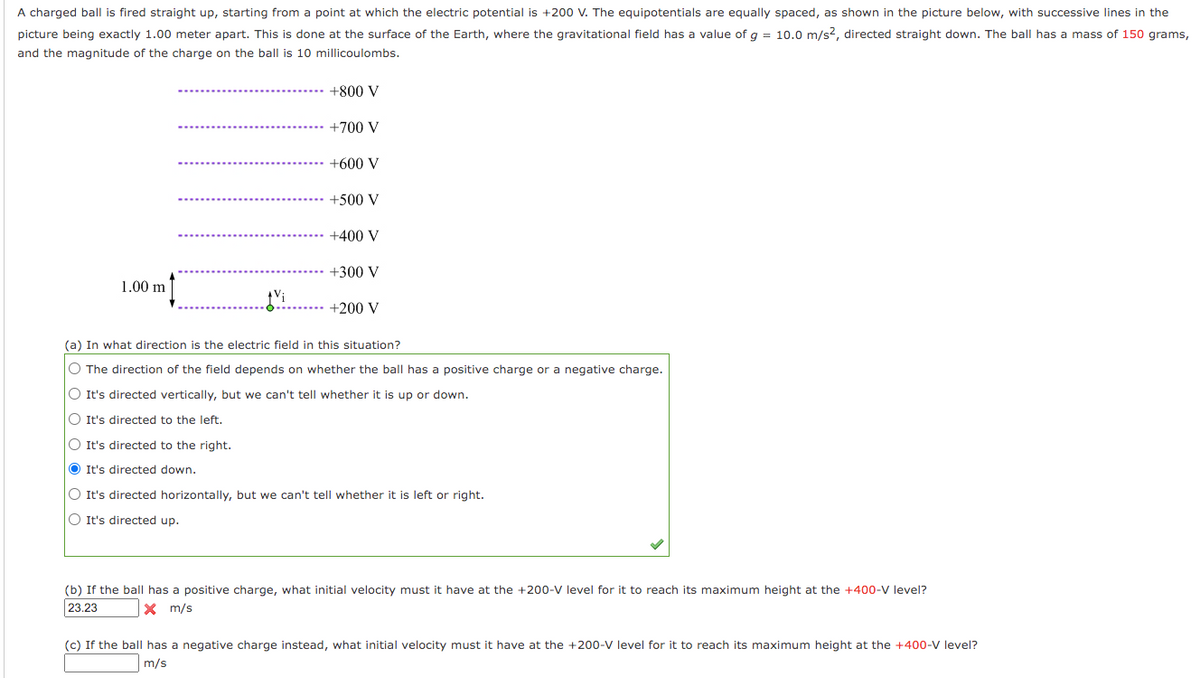A charged ball is fired straight up, starting from a point at which the electric potential is +200 V. The equipotentials are equally spaced, as shown in the picture below, with successive lines in the picture being exactly 1.00 meter apart. This is done at the surface of the Earth, where the gravitational field has a value of g = 10.0 m/s?, directed straight down. The ball has a mass of 150 grams, and the magnitude of the charge on the ball is 10 millicoulombs. +800 V +700 V +600 V +500 V +400 V +300 V 1.00 m Vi +200 V (a) In what direction is the electric field in this situation? O The direction of the field depends on whether the ball has a positive charge or a negative charge. O It's directed vertically, but we can't tell whether it is up or down. O It's directed to the left. O It's directed to the right. O It's directed down. O It's directed horizontally, but we can't tell whether it is left or right. O It's directed up. (b) If the ball has a positive charge, what initial velocity must it have at the +200-V level for it to reach its maximum height at the +400-V level? 23.23 X m/s (c) If the ball has a negative charge instead, what initial velocity must it have at the +200-V level for it to reach its maximum height at the +400-V level? m/s
A charged ball is fired straight up, starting from a point at which the electric potential is +200 V. The equipotentials are equally spaced, as shown in the picture below, with successive lines in the picture being exactly 1.00 meter apart. This is done at the surface of the Earth, where the gravitational field has a value of g = 10.0 m/s?, directed straight down. The ball has a mass of 150 grams, and the magnitude of the charge on the ball is 10 millicoulombs. +800 V +700 V +600 V +500 V +400 V +300 V 1.00 m Vi +200 V (a) In what direction is the electric field in this situation? O The direction of the field depends on whether the ball has a positive charge or a negative charge. O It's directed vertically, but we can't tell whether it is up or down. O It's directed to the left. O It's directed to the right. O It's directed down. O It's directed horizontally, but we can't tell whether it is left or right. O It's directed up. (b) If the ball has a positive charge, what initial velocity must it have at the +200-V level for it to reach its maximum height at the +400-V level? 23.23 X m/s (c) If the ball has a negative charge instead, what initial velocity must it have at the +200-V level for it to reach its maximum height at the +400-V level? m/s
Chapter7: Electric Potential
Section: Chapter Questions
Problem 77P: An election enters a region between two large parallel plates made of aluminum separated by a...
Related questions
Question

Transcribed Image Text:A charged ball is fired straight up, starting from a point at which the electric potential is +200 V. The equipotentials are equally spaced, as shown in the picture below, with successive lines in the
picture being exactly 1.00 meter apart. This is done at the surface of the Earth, where the gravitational field has a value of q = 10.0 m/s?, directed straight down. The ball has a mass of 150 grams,
and the magnitude of the charge on the ball is 10 millicoulombs.
+800 V
+700 V
+600 V
+500 V
+400 V
+300 V
1.00 m
+200 V
(a) In what direction is the electric field in this situation?
O The direction of the field depends on whether the ball has a positive charge or a negative charge.
O It's directed vertically, but we can't tell whether it is up or down.
O It's directed to the left.
O It's directed to the right.
O It's directed down.
O It's directed horizontally, but we can't tell whether it is left or right.
O It's directed up.
(b) If the ball has a positive charge, what initial velocity must it have at the +200-V level for it to reach its maximum height at the +400-V level?
23.23
X m/s
(c) If the ball has a negative charge instead, what initial velocity must it have at the +200-V level for it to reach its maximum height at the +400-V level?
m/s
Expert Solution
Step 1 - Introduction
Given
distance between successive lines
gravitational acceleration
mass of ball
charge
Trending now
This is a popular solution!
Step by step
Solved in 3 steps

Knowledge Booster
Learn more about
Need a deep-dive on the concept behind this application? Look no further. Learn more about this topic, physics and related others by exploring similar questions and additional content below.Recommended textbooks for you


Principles of Physics: A Calculus-Based Text
Physics
ISBN:
9781133104261
Author:
Raymond A. Serway, John W. Jewett
Publisher:
Cengage Learning

Physics for Scientists and Engineers: Foundations…
Physics
ISBN:
9781133939146
Author:
Katz, Debora M.
Publisher:
Cengage Learning


Principles of Physics: A Calculus-Based Text
Physics
ISBN:
9781133104261
Author:
Raymond A. Serway, John W. Jewett
Publisher:
Cengage Learning

Physics for Scientists and Engineers: Foundations…
Physics
ISBN:
9781133939146
Author:
Katz, Debora M.
Publisher:
Cengage Learning

Classical Dynamics of Particles and Systems
Physics
ISBN:
9780534408961
Author:
Stephen T. Thornton, Jerry B. Marion
Publisher:
Cengage Learning